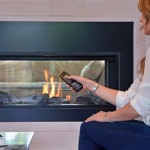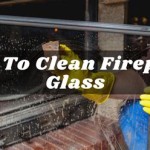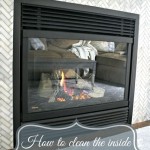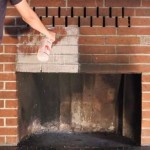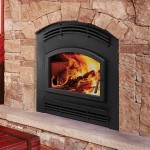How To Convert A Wood Burning Fireplace Into Gas
Converting a wood-burning fireplace into a gas fireplace offers a blend of convenience and efficiency. The transition eliminates the need for sourcing, storing, and hauling firewood, while providing instant heat and controlled flames. This process involves careful planning, adherence to safety regulations, and, in many cases, professional installation to ensure optimal performance and safety.
Before initiating the conversion, a thorough assessment of the existing fireplace is crucial. Evaluate the chimney's condition, ensuring it is free from obstructions and structurally sound. A chimney sweep service is recommended to remove creosote buildup, which can pose a significant fire hazard regardless of the fuel source. The fireplace's firebox should also be inspected for cracks or damages, which may require repair or relining prior to the gas conversion.
Selecting the appropriate gas insert or log set is a key decision. Consider the fireplace's dimensions and desired heat output when choosing a unit. Gas inserts are self-contained units that slide into the existing firebox, offering higher efficiency and heat control. Gas log sets, on the other hand, provide a more traditional aesthetic, mimicking the appearance of burning wood. However, they typically offer lower efficiency compared to inserts. There are vented and ventless options. Vented log sets require a functioning chimney to expel exhaust gases, while ventless models do not, but they may have limitations regarding room size and ventilation requirements.
Determining the Type of Gas Connection
The type of gas connection available at the property—natural gas or propane—will influence the selection of the gas insert or log set. Appliances are specifically designed to operate on one type of gas, and using the incorrect fuel can lead to malfunction and safety hazards. If the property already has a natural gas line, tapping into it for the fireplace is generally the most cost-effective option. If natural gas is not available, a propane tank will need to be installed and connected to the fireplace. In this case, adherence to local regulations regarding propane tank placement and safety is paramount. The gas line connection itself should be performed by a licensed gas fitter to ensure compliance with safety codes and prevent gas leaks.
Obtaining the necessary permits is an essential step in the conversion process. Local building codes often require permits for gas line installations and fireplace modifications. Contact the local building department to determine the specific requirements and obtain the appropriate permits before commencing any work. Failure to obtain the necessary permits can result in fines, delays, and potential safety hazards.
Installing a gas line requires careful planning and execution. A licensed gas fitter should perform the installation, ensuring that the gas line is properly sized, routed, and connected to the fireplace and the main gas supply. Safety precautions, such as leak testing and pressure testing, must be implemented throughout the installation process to prevent gas leaks. The gas line should be installed in accordance with local codes and manufacturer's instructions.
Installation of the Gas Fireplace Insert or Log Set
The installation of the gas insert or log set involves connecting the unit to the gas line and setting it properly within the firebox. Follow the manufacturer's instructions meticulously to ensure proper installation and operation. For gas inserts, this typically involves sliding the unit into the firebox, connecting the gas line, and sealing the unit to the fireplace opening. For gas log sets, the logs are arranged on a grate or burner assembly, and the gas line is connected. Ensure that the logs are positioned correctly to allow for proper combustion and flame distribution.
Ventilation requirements vary depending on the type of gas fireplace unit being installed. Vented gas fireplaces require a functioning chimney to expel exhaust gases. The chimney should be inspected and cleaned before installing a vented gas fireplace. Ventless gas fireplaces do not require a chimney, but they must be installed in a room that meets minimum size and ventilation requirements. Follow the manufacturer's instructions carefully to ensure proper ventilation and prevent the buildup of carbon monoxide.
After the installation is complete, a thorough inspection and testing are necessary to ensure safe and proper operation. A qualified technician should inspect the gas line connections for leaks, test the ignition system, and verify that the fireplace is operating efficiently. Carbon monoxide detectors should be installed in the vicinity of the fireplace to provide an early warning in case of carbon monoxide buildup. Regularly inspect and maintain the fireplace and chimney to prevent problems and ensure long-term safety.
Safety Checks and Maintenance
Carbon monoxide detectors are crucial safety devices in any home with a gas fireplace. Ensure that these detectors are functioning properly and that the batteries are regularly replaced. Educate all household members about the signs and symptoms of carbon monoxide poisoning and what to do if a carbon monoxide alarm sounds.
Regular maintenance is essential for ensuring the safe and efficient operation of a gas fireplace. Schedule annual inspections and servicing by a qualified technician. These inspections should include cleaning the burner assembly, checking the gas line connections, and inspecting the venting system. Clean the fireplace glass regularly to maintain visibility of the flames and improve aesthetics. Remove any debris or obstructions from the fireplace and chimney.
Converting a wood-burning fireplace to gas offers numerous benefits, including convenience, efficiency, and ease of use. However, it is a project that requires careful planning, adherence to safety regulations, and, in many cases, professional installation. By following these guidelines, homeowners can safely and effectively convert their wood-burning fireplaces to gas, enjoying the warmth and ambiance of a fireplace with the convenience of gas fuel.
The conversion from wood to gas requires careful consideration of the property’s infrastructure and adherence to local regulations. Prioritize safety throughout the entire process, engaging qualified professionals for tasks such as gas line installation and system inspection.
Converting A Wood Burning Fireplace Into Gas Heat Glo

Convert From Wood To Gas With A Insert The Kernel Burner
Can I Convert My Wood Burning Fireplace To Gas Woodlanddirect Com

How To Convert Your Wood Burning Fireplace Electric Or Gas
Can I Convert My Wood Burning Fireplace To Gas Woodlanddirect Com

Can A Wood Burning Fireplace Be Converted To Gas The Flame Company

Convert Your Old Wood Fireplace To A Gas

Convert A Wood Fireplace To Gas Full Service Chimney

Diy Fireplace Makeover How To Convert A Wood Burning An Touchstone Home S Inc
Converting A Wood Burning Fireplace Into Gas Read This First Heatilator
Related Posts

